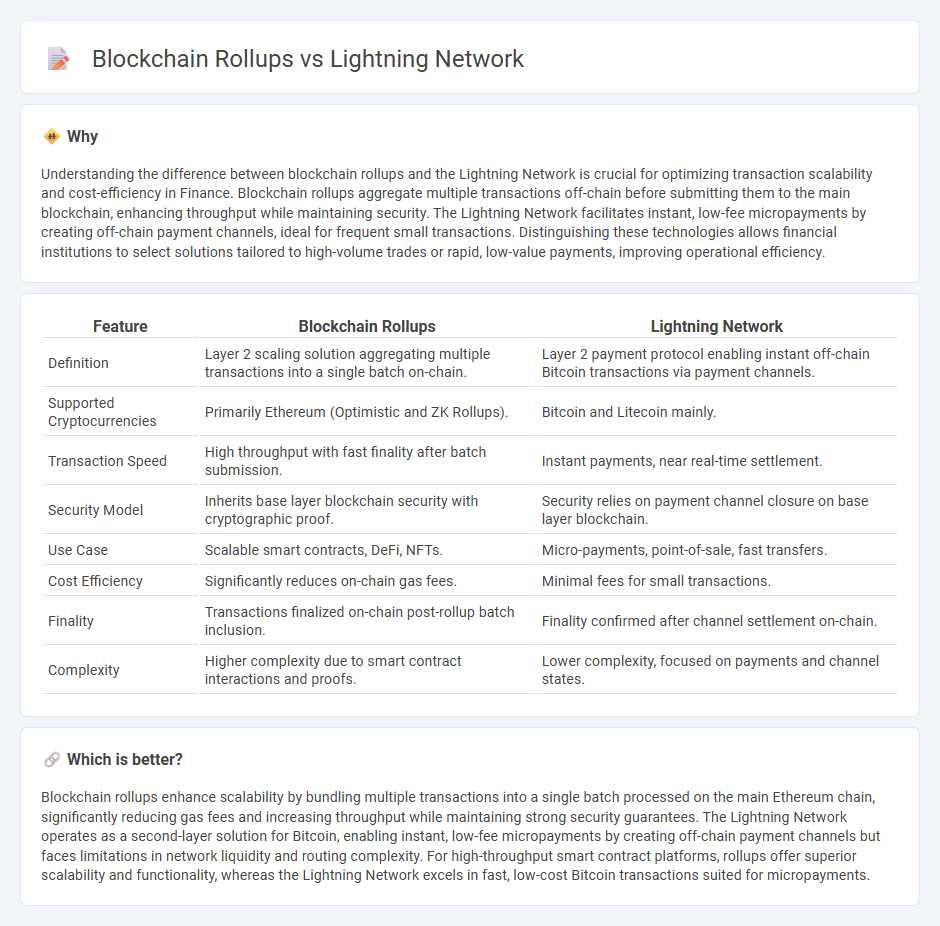
Blockchain rollups enhance scalability by processing transactions off-chain and bundling them into a single proof on the main blockchain, reducing congestion and lowering fees. The Lightning Network facilitates instant, low-cost Bitcoin payments through off-chain channels, enabling micropayments without overloading the base layer. Explore the technical differences and use cases of blockchain rollups versus the Lightning Network to optimize your financial strategies.
Why it is important
Understanding the difference between blockchain rollups and the Lightning Network is crucial for optimizing transaction scalability and cost-efficiency in Finance. Blockchain rollups aggregate multiple transactions off-chain before submitting them to the main blockchain, enhancing throughput while maintaining security. The Lightning Network facilitates instant, low-fee micropayments by creating off-chain payment channels, ideal for frequent small transactions. Distinguishing these technologies allows financial institutions to select solutions tailored to high-volume trades or rapid, low-value payments, improving operational efficiency.
Comparison Table
| Feature | Blockchain Rollups | Lightning Network |
|---|---|---|
| Definition | Layer 2 scaling solution aggregating multiple transactions into a single batch on-chain. | Layer 2 payment protocol enabling instant off-chain Bitcoin transactions via payment channels. |
| Supported Cryptocurrencies | Primarily Ethereum (Optimistic and ZK Rollups). | Bitcoin and Litecoin mainly. |
| Transaction Speed | High throughput with fast finality after batch submission. | Instant payments, near real-time settlement. |
| Security Model | Inherits base layer blockchain security with cryptographic proof. | Security relies on payment channel closure on base layer blockchain. |
| Use Case | Scalable smart contracts, DeFi, NFTs. | Micro-payments, point-of-sale, fast transfers. |
| Cost Efficiency | Significantly reduces on-chain gas fees. | Minimal fees for small transactions. |
| Finality | Transactions finalized on-chain post-rollup batch inclusion. | Finality confirmed after channel settlement on-chain. |
| Complexity | Higher complexity due to smart contract interactions and proofs. | Lower complexity, focused on payments and channel states. |
Which is better?
Blockchain rollups enhance scalability by bundling multiple transactions into a single batch processed on the main Ethereum chain, significantly reducing gas fees and increasing throughput while maintaining strong security guarantees. The Lightning Network operates as a second-layer solution for Bitcoin, enabling instant, low-fee micropayments by creating off-chain payment channels but faces limitations in network liquidity and routing complexity. For high-throughput smart contract platforms, rollups offer superior scalability and functionality, whereas the Lightning Network excels in fast, low-cost Bitcoin transactions suited for micropayments.
Connection
Blockchain rollups and the Lightning Network both enhance blockchain scalability by processing transactions off-chain while maintaining security through the main blockchain. Rollups aggregate multiple transactions into a single batch submitted on-chain, significantly reducing congestion on Ethereum and similar networks. The Lightning Network enables instant, low-fee payments on Bitcoin by creating off-chain payment channels, complementing rollups' approach to optimizing transaction throughput and lowering costs on layer-2 solutions.
Key Terms
Payment Channels
Lightning Network utilizes payment channels to enable fast, low-fee transactions off the main blockchain, significantly enhancing Bitcoin's scalability and reducing network congestion. Blockchain rollups bundle multiple transactions into a single batch processed on-chain, improving throughput while still relying on the main chain's security. Explore how payment channels can revolutionize everyday transactions with instant settlements and minimal costs.
Layer 2 Scalability
Lightning Network enables near-instant micropayments by creating off-chain payment channels on the Bitcoin blockchain, drastically reducing transaction fees and congestion. Blockchain rollups, including Optimistic and ZK rollups, batch multiple Layer 2 transactions into a single proof submitted on-chain, enhancing Ethereum's scalability and security. Explore deeper insights into how Layer 2 solutions revolutionize blockchain throughput and user experience.
Off-chain Transactions
Lightning Network and blockchain rollups both enhance scalability through off-chain transactions but differ fundamentally in approach and application. Lightning Network operates via payment channels enabling instant, low-fee Bitcoin transactions off-chain, ideal for micro-payments. Explore further to understand how these technologies revolutionize blockchain efficiency and user experience.
Source and External Links
Lightning Network - A decentralized network built on blockchain smart contracts enabling instant payments across participants, enhancing transaction speed and efficiency.
What is the Lightning Network? - A layer-2 protocol that allows fast and cheap Bitcoin transactions by moving payments off the main blockchain, useful for micropayments and mass adoption scenarios like tipping or cross-border transfers.
What is the Bitcoin Lightning Network, and how does it work? - A layer-2 scaling solution using payment channels between parties, enabling nearly instant, low-cost Bitcoin transactions by settling only opening and closing on-chain while conducting unlimited off-chain transactions.
 dowidth.com
dowidth.com